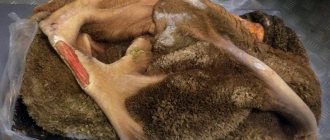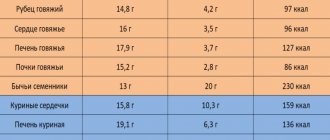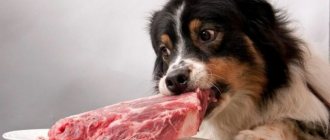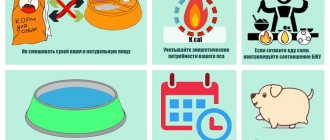An owner who loves his pet strives to provide him with healthy, varied food. If a dog receives ready-made food, the manufacturer most likely took care of the benefits of such food. But there are dogs that, for one reason or another, eat exclusively natural food. And then the owner has a lot of questions related to the benefits or harm of certain products. One of them is whether dogs can have chicken liver, beef kidneys or heart, in general, what is commonly called offal.
Benefit
This product is beneficial for both people and dogs. The liver contains many vitamins (including vitamins B, E, D), as well as a considerable amount of minerals (iron, zinc, copper and sodium. Amino acids are also present in the offal.
In addition, liver contains a lot of protein (even more than meat). This element is a building material for muscles, as well as supporting components for the normal functioning of ligaments and tendons.
Another beneficial property of the liver is the ability to increase hemoglobin, which directly affects the dog’s overall health, physical activity, and energy.
The product contains an element called heparin, which is responsible for good blood circulation in all organs.
Chicken liver is considered a dietary product - it contains virtually no fat. Reference! By the amount of vitamin D, offal products have no equal. Even dry food, the composition of which is developed by specialists, cannot compare with liver. Vitamin D is especially important for those animals that live in northern regions with few sunny days.
The most valuable by-products for dogs
The value of offal for dogs largely depends on its protein content. Some of them can almost completely replace muscle meat. In addition, some offal is a real concentrate of vitamins. Let's take a closer look at each product.
Tripe (beef/lamb)
The rumen is the first and largest of the three forestomachs of ruminants. Its wall is muscular, and the inside is covered with a huge amount of villi. Stores sell peeled, white tripe. But dog lovers prefer to give their pets unpurified, black. It is traditionally considered a "source of enzymes and microorganisms."
Uncleaned scar: dark-colored villi
Cleaned tripe - light
Now you can throw stones at me, but I'm going to debunk this myth. The rumen does not contain any enzymes or digestive juices at all. Enzymes are produced by the pancreas and, to a lesser extent, by the abomasum, the true stomach. In the rumen, digestion occurs due to a huge colony of microorganisms. About these bacteria. They are extremely useful for cows, but rather useless for dogs. In the acidic environment of the stomach of predators, these microorganisms (assuming they survived the journey from the slaughterhouse to the counter and freezer) simply die and are digested.
So yes, you can give your dog peeled tripe. And even (oh God, the barfists will curse me now) boil it. It will still be a fairly valuable source of protein, albeit without any magical properties.
Be careful: under the guise of tripe, lesser-known proventriculi of ruminants - a mesh and a book - are often sold
If you are convinced of the benefits of raw black tripe, here are a couple of tips:
- cut it with gloves, otherwise the smell will eat into your hands;
- wrap the cutting board in several layers of film;
- if the smell seems unbearable, feed the dog tripe in the form of frozen strips, or use a respirator.
In any case, it is the smell, which is unpleasant to humans, that makes tripe so attractive to dogs. It is even sold dried in powder form, as a flavoring for dry or natural food to whet your pet's appetite.
Beef/chicken/turkey liver
Liver is a special by-product. It should not be taken as a meat substitute, but as a therapeutic vitamin supplement. In small quantities it is incredibly useful, in large quantities it is truly dangerous.
The liver serves as a source of:
- Fat-soluble vitamins: A (retinol), to a lesser extent – E and K;
- B vitamins (B2, B3, B5, B9, B12);
- Microelements: potassium, iron, zinc, selenium, copper;
- Essential amino acids.
You can give dogs both raw and boiled liver, depending on what kind of food system you have chosen for your pet.
Beef liver is easy to find in stores
Liver must be included in the diet, but the amount should not exceed 5% of the diet. One serving, depending on the weight of the dog, can be a microdose of 5-20 grams, for large dogs - 50-100 g. Liver is given 2 times a week.
Chicken liver is often sold in hypermarkets
Heart (beef, turkey, chicken, lamb)
Heart is comparable in nutritional value to muscle meat. However, it is very dense and contains large amounts of collagen and elastin. Just like tripe, heart can completely replace meat in one of the feedings. It is fed raw or boiled, 3-4 times a week, in an amount of 15% of the total diet.
Beef heart. The heart of a calf weighs about 800 g, an adult cow - 1.5-2 kg
Poultry hearts are a rather fatty product, and in beef heart the vascular areas are difficult to digest. Visible fat and veins can be removed during cutting. In any case, if the dog has not previously received this by-product, you should start feeding it with a small amount in order to monitor the body’s reaction.
Harm
Of course, any product has its limitations and contraindications, which dog owners should be aware of so as not to harm their pet.
This offal contains a large amount of vitamin A. If you give dogs too much liver, they may experience a vitamin overdose. This process in the body causes muscle weakness, bone spurs, and malfunctions of the digestive system.
There is also a danger that the offal may contain hormones and various food additives that were fed to the chicken.
Contraindications
The offal itself can be harmful only because it contains a lot of cholesterol.
Experts do not recommend introducing it into your pet’s diet in several cases:
- Old age of the dog.
- The presence of pathologies of the gastrointestinal tract.
- Kidney problems.
- Manifestation of food allergies.
- Pregnancy in females.
In all other cases, the liver, if properly processed, will not harm the health of the pet.
How to give?
It is recommended to give this product no more than twice a week. You can mix it with various cereals. Liver should not be allowed to become the only source of protein for dogs. Be sure to alternate liver with other offal (ventricles and hearts are especially useful) or meat.
You can give no more than 300 grams of product at a time, depending on the size of the dog.
How much and when?
Even in a homemade diet, liver should not be used as the main or sole source of protein. To get the best results from raw feeding and other similar diets, your puppy needs a variety of foods to stay healthy and receive the most nutrients. Liver as a treat is ideal for adding variety to the diet as most dogs really enjoy the taste. Small portions of liver, preferably boiled, up to a couple of times a week, but no more, will be an ideal additional dish for your pet.
Small breeds of dogs, such as Yorkshire Terrier, Pekingese, Chihuahua, Dachshund, Toy Terrier or, for example, Spitz, can be given both beef and chicken liver, but in limited quantities 1-2 times a week, because, among other things, it can cause diarrhea.
Adequate nutrition is the key to the proper development and health of your pet. To diversify the daily diet of animals, owners often use offal as a supplement to the main food. By-products for dogs are presented in various versions: liver, kidneys, brains, etc. However, such nutrition may not always benefit the pet
Therefore, it is important to understand the issue of the benefits and harms of offal
Should I feed it raw?
Adherents of a raw food diet say that dogs can be fed raw chicken liver. And until recently, almost all pets were fed this way. There is nothing wrong with a raw product.
However, at the moment there is a risk of falling for unscrupulous sellers and purchasing a liver infected with helminths, which do not die even after prolonged freezing.
In addition, in modern conditions, dogs have even become overly domesticated animals, so they are recommended to be fed with thermally processed foods. This will help avoid food poisoning and further digestive problems.
Liver deficiencies
Before you start giving your dog liver, it is important to evaluate the possible risks and consequences. Despite the fact that offal such as beef or chicken liver contains a large number of useful elements, you need to be careful when using it
Due to the fact that the liver contains a high concentration of retinol, an overdose or hypervitaminosis may develop when feeding a dog. The consequences of an overdose of vitamin A lead to roughening of the skin, specific growths on the bones, weakness of muscle fibers, and disturbances in the functioning of the digestive system.
In addition, when feeding liver to a dog, you need to be sure that the fattening bird did not receive various additives and hormonal substances. The dog may develop an allergic type reaction, up to and including anaphylactic shock (in some of the most sensitive animals).
Raw beef liver obtained from disadvantaged agricultural farms may contain helminth infections (liver flukes), which can cause serious problems in the functioning of the dog’s body.
There are a number of contraindications that you need to know before feeding your dog this offal.
Contraindications are:
- acute intolerance to the protein contained in chicken meat;
- failure of renal structures (in fact, the liver is a source of pure protein, the amount of which should be reduced in diseases of the renal system in pets);
- increased blood cholesterol levels;
- allergic type reactions.
It is not recommended to feed dogs liver that is frozen or obviously spoiled. Most of the negative consequences after a dog eats beef or chicken liver are associated with these factors.
In the absence of health contraindications, a properly stored liver is not only necessary, but also indispensable for dogs for normal growth, development and maintenance of the body’s immune forces at the proper level.
It is important to remember that excessive consumption of liver can provoke the development of not only food allergies, but also other disorders in the body. Nausea, stool disorders, skin rashes in the ears, axillary and groin areas may occur.
If you notice a specific reaction in your pet, you must immediately stop using offal to avoid serious consequences.
How to choose?
The most important criterion for a product is that it must be fresh and natural. To purchase just such an offal, when purchasing you need to pay attention to the following points:
- the surface must be smooth and free of any inclusions;
- color – brown, with a burgundy tint;
- Do not under any circumstances purchase an offal that has a loose consistency - this indicates either the old age of the product or its improper storage;
- refuse to buy orange liver - it has already been frozen several times;
- liver with a green tint indicates that the gallbladder burst during processing, and now because of this the liver has a bitter taste.
Offal and chicken heads for dogs
Veterinarians recommend feeding your pet not only chicken.
Many owners of shaggy dogs are wondering what to feed their dog and whether it can be given chicken by-products. The answer is yes. Poultry meat and bones contain useful substances and vitamins necessary for the health of your pet. The main thing is to cook and serve it correctly.
A dog’s complete nutrition consists of animal proteins, which are found in lean meat, cartilage, and tendons. The diet should also include fats. An inexpensive option that meets these conditions is chicken by-products.
Poultry is more of an addition to a dog’s diet, which consists of beef or lamb.
There are several varieties of chicken by-products, depending on the body part of the chicken. For example:
- Heads. This product contains calcium, so your pet will be happy to eat chicken heads and benefit their teeth. To begin with, the heads are washed, then scalded with boiling water, boiled and only then served to the dog. Before you give the dog a head, you need to remove the beak. Not only does it not contain useful substances, it can damage your pet’s esophagus. Veterinarians advise against overusing this product. They cannot replace a full-fledged piece of head meat, as they do not contain protein.
- Paws. They contain many useful substances: rich in collagen and amino acids. Experts recommend preparing jellied meat from this offal. To begin with, the paws are boiled, then the resulting broth is cooled, and the bones are separated from the offal, the soft tissues are removed, and the claws are removed. Jellied meat will be an excellent addition to porridge, which is cooked separately for your pet. You can only treat your dog with jellied meat. This food is especially useful for puppies. It will have a beneficial effect on the condition of joints, skin and coat. It is better to serve the paws only when they are cleared of bones and claws, otherwise the pet may choke and damage the esophagus.
- Necks. This product can even be given to puppies as it does not contain bones. The necks are boiled, poured over with boiling water and served to the pet. The dog will easily chew on the treat, which is easily digestible. Some owners make minced chicken necks along with other cartilage.
- Bones. Controversy continues to surround this by-product. Some say that bones are strictly forbidden to be given to dogs, while others insist that there is nothing wrong with them. But both agree on one thing: you should never feed your pet tubular bones. The tails cannot chew them and immediately swallow them.
Tubular bones form sharp stakes and damage the intestines. This is especially dangerous for puppies and small breeds.
Many experts note that boiled bones are contraindicated for dogs. The fact is that they are poorly digested and make it difficult for your pet to pass stool. Because of this, the pet feels unwell. In addition, no useful substances remain in boiled bones; all of them are destroyed during the cooking process.
Owners who often give their dogs boiled bones may encounter a problem, since, in essence, such a product is rot. This, in turn, clogs the intestines.
Raw bones are healthier. They are given to pets to chew on as they strengthen their teeth. Nevertheless, some owners still recommend giving beef bones for this purpose.
How to cook?
How long to cook?
The simplest and most correct way to prepare liver is to boil it. This is done within a few minutes. With prolonged cooking, the product only becomes harder and significantly loses not only its taste, but also the amount of nutrients.
Many experts recommend just pouring boiling water over the product - this will be enough.
- Salt should not be used during cooking, even in small doses.
- You can mix liver with buckwheat porridge - this is the healthiest combination of foods, rich in folic acid.
- You can also stew the liver, but it is advisable not to fry the product - after this procedure, too much harmful fat accumulates in it.
- After cooking, the liver is cooled and then crushed.
Treat recipe
You can not just boil the liver, but also prepare a delicacy from it. Let us present you with a simple recipe for making homemade food.
Reference! If up to this time your pet has been eating only dry food, such a treat may cause an upset stomach.
- You need to take a kilogram of liver, a couple of cloves of garlic and vegetable oil.
- It is advisable to soak the liver before cooking to protect dogs from harmful substances. Soaking time is approximately 4 hours. The water will tell you the exact time. It needs to be drained periodically and the product kept until the water becomes clear.
- You need to cut the liver into small cubes. Then there are two cooking options. You can place the product in the microwave and cook it there at the lowest power for half an hour.
- Or you can place the pieces on a baking sheet and put it in the oven. Baking temperature is average, time is approximately 25-35 minutes. In this case, the baking sheet must be greased with vegetable oil.
Reference! The time it takes until the treat is completely ready depends on the size of the pieces. You need to periodically test them for hardness so that the dish does not turn out hard and dry.
The finished product is stored in a cool place (ideally in the refrigerator). It should be used within 2-3 days.
Recommendations and restrictions
You should not give your tailed river fish, only ocean fish, always low-fat varieties. It is better to boil it so that the cat does not become infected with helminths, after removing the offal and bones.
There is an opinion that milk should not be given to cats, since it is poorly digested in adulthood. There is no need to exclude fermented milk products from your diet.
The last thing you need to add to your cat's diet is cereal (oatmeal, rice and buckwheat). But this does not mean that they are completely useless. Porridges are a source of vitamins, fiber and carbohydrates. However, the tailed pet does not have a special need for the latter, so there is no point in feeding it porridge every day.
Advantages and disadvantages of Wellness CORE cat food
Supplements to your usual diet may include:
- vegetable oil;
- bone flour;
- brewer's yeast;
- fish fat.
In feed
When the owner himself prepares food for his pet, he knows exactly where he purchased the products and what quality they are.
However, careless animal feed manufacturers very often use low-quality products .
In most cases, for the production of feed, the liver is purchased that for some reason is unsuitable for sale to people . For example, if by-products are not refrigerated within 24 hours after slaughtering animals, they become unsuitable for human consumption. But they are often used for feed production.
also unknown why the animals died . The food is produced from the offal of animals that die due to the destructive effects of nature, due to disease, often gutting animals that died in the zoo or during transportation.
To purchase quality food, pay attention to its composition. In addition to the name of the offal, its source must also be indicated. For example, “beef meat” or “chicken liver”. Please note that the liver should not be the first in the list of feed compositions.
Preparation
In order for your four-legged friend to happily devour boiled liver, it must be prepared correctly. First, the piece must be cleared of veins, then rinsed and placed in cold water for about 30-40 minutes. After this, put on moderate heat and cook for about 25-30 minutes.
You can add vegetables to this dish (carrots, white cabbage, zucchini, cauliflower). This way the liver will be saturated with a pleasant vegetable aroma and become even tastier.
The liver can not only be boiled, but also stewed. But it is not recommended to give it fried to a dog. Because during frying it becomes tougher, drier and less healthy (cholesterol levels increase).
Recipes
In addition to primitive dishes, you can create real culinary masterpieces, such as pate or liver pancakes. For the pate you will need:
- 200 grams of liver;
- 1 tbsp. spoon of cream;
- 1 teaspoon of vegetable oil.
Clean the liver and cut it into small pieces. Simmer it with vegetable oil over low heat for 10-15 minutes, then add a spoonful of cream, then grind the mass in a blender.
The pate can be given to your dog in the form of small balls or mixed with your favorite porridge.
For pancakes take:
- 100 gr. liver;
- 50 gr. butter;
- 1 teaspoon of vegetable oil;
- 1 chicken egg.
Rinse the liver and grind in a blender, then add butter and egg. Add vegetable oil to a hot frying pan and pour in the pancakes. Let the crust “set”, then cover with a lid. Simmer for about 10-15 minutes.
For puppies
Poultry liver is not only possible, but also should be given to puppies. It contains a large amount of vitamin B, which is responsible for the proper development of the nervous system.
The offal is boiled and introduced into the diet of a young dog as complementary food. A few small pieces two to three times a week will be enough.
If you give your puppy liver more often, his bones may become deformed, and he may also develop allergies, which will cause poor overall development and weight loss.
You can introduce liver into your puppy’s diet from the second month of life.
Features of using liver for dogs
Despite the fact that liver is an extremely healthy product, it can be given to adult healthy dogs with some reservations:
- First of all, chicken and beef liver will be beneficial for the dog, while goose and pork liver should not be included in the diet due to their high lipid content.
- Feeding your dog liver should be limited due to its high content of retinol, an overdose of which can cause bone growths and changes in the quality of the skin and coat.
- You need to be careful when purchasing this by-product. You should only choose from trusted manufacturers who are responsible for keeping animals. The presence of helminth larvae or residues of hormones and food additives in the liver can seriously undermine the dog’s health.
One should not write off a dog’s individual intolerance to chicken or beef liver and the peculiarities of its health. These include:
- chicken protein intolerance;
- renal failure;
- high cholesterol;
- allergies of unknown etiology.
Choosing a quality product
It is extremely important to choose a liver responsibly so as not to harm your pet.
Several important nuances deserve attention.
The offal should have a red-brown tint. It is unacceptable to have any stains on it. The liver's blood is scarlet. If it is dark, then the product is clearly stale.
Smell
Normally, the product emits a sweetish aroma. A slight smell of ammonia indicates its staleness.
Fresh or frozen
You can find both fresh and frozen products on sale. The second option, as a rule, is cheaper than the first, but it contains significantly fewer useful elements.
Treat bag
A bag that attaches to your belt, which is convenient for adding reward pieces, is sold in many pet stores. But so that it matches the color of your outfit, is of the required size, and can accommodate a bottle of water, you can sew it yourself .
The fabric of the bag should be waterproof so that the food does not get damaged. Most often it is made with a round or oval bottom, cylindrical sides and a cord tightened at the top.
It is important to attach a carabiner for easy fastening to jeans.
To make it convenient to get the food , but at the same time it does not fall out when running or bending, you should replace the lace with an elastic band.











